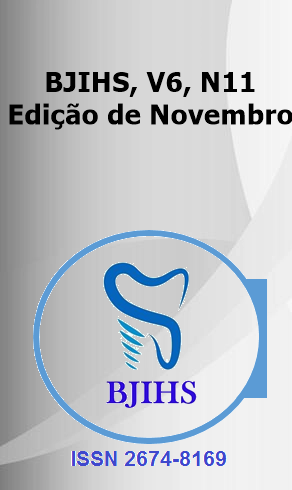Abstract
The objective of this study is to expose the importance of early diagnosis and treatment to contribute to a good prognosis. This is a narrative review of a critical and analytical nature, in research on the main concepts regarding Deep Vein Thrombosis. A review of articles was carried out in the Scientific Electronic Library Online (SciELO) and PubMed databases, with the following Health Sciences Descriptors (DeCS): Brain; Neurology; Thrombosis. Cerebral Venous Thrombosis (CVT) is characterized by the obstruction of intracranial veins and venous sinuses, representing a relatively rare cerebrovascular condition, with a prevalence of approximately 5 cases per 1,000,000 inhabitants globally. This condition can affect individuals of any age group, including newborns, with a peak incidence in young adults, mainly between 30 and 40 years old, being more prevalent in women, with a ratio of three women for every affected man. This gender disparity can be attributed to etiological factors associated with CVT, such as the use of oral contraceptives, pregnancy and the postpartum period. The clinical signs of CVT, which are often nonspecific, highlight the importance of detailed evaluation and imaging methods, such as magnetic resonance imaging and magnetic resonance venography, for diagnostic confirmation. Treatment, which involves anticoagulation and symptomatic approaches, must be initiated quickly to optimize results and reduce associated morbidity.
References
EINHÄUPL, K. et al. EFNS Guideline on the Treatment of Cerebral Venous and Sinus Thrombosis in Adult Patients. European Journal of Neurology, 2010, Londres, pp. 1229-1235.
SAPOSNIK, G. et al. Diagnosis and Management of Cerebral Venous Thrombosis: A Statement for Healthcare Professionals From the American Heart Association/American Stroke Association. Journal of the American Heart Association, Baltimore, 14 fev. 2011, pp. 1-36.
FERRO, J. M.; CANHÃO, P. Cerebral Venous Sinus Thrombosis: Update on Diagnosis and Management. Stroke (AB SINGHAL, SECTION EDITOR), Nova York, 30 jul. 2014. DOI: 10.1007/s11886-014-0523-2.
STAM, J. et al. Thrombosis of the Cerebral Veins and Sinuses. The New England Journal of Medicine, Amsterdam, 28 abr. 2005.
SILVIS, S. M. et al. Cerebral Venous Thrombosis. Nature Reviews Neurology, Lisboa, 18 ago. 2017.
SIDDIQUI, F. M. et al. Mechanical Thrombectomy in Cerebral Venous Thrombosis: Systematic Review of 185 Cases. Stroke, Toronto, 7 jan. 2015.
BOUSSER, M. G.; FERRO, J. M. Cerebral Venous Thrombosis: An Update. The Lancet Neurology, Paris, v. 6, 2007, pp. 162-170.
DIACINTI, D. et al. Cerebral Venous Thrombosis: A Case Series and a Neuroimaging Review of the Literature. Journal of Clinical Neuroscience, Austrália, 10 sept. 2018, vol. 58, pp. 142-147.
CASTRO, Luana Fernandes da Silva Oliveira et al. Trombose venosa cerebral: a relevância da neuroimagem. Revista Eletrônica Acervo Saúde, v. 13, n. 8, p. e8498-e8498, 2021.
DOS SANTOS, Maria Hortencia Borges et al. Aspectos epidemiológicos sobre COVID-19 e a relação com trombose venosa em tempos de pandemia: uma revisão de literatura. RECIMA21-Revista Científica Multidisciplinar-ISSN 2675-6218, v. 2, n. 6, p. e26508-e26508, 2021.
TANAJURA, Rodrigo Rodrigues et al. Perfil epidemiológico de trombose venosa cerebral em um hospital de Salvador-BA: Proposta de projeto de pesquisa. Research, Society and Development, v. 11, n. 7, p. e31211730051-e31211730051, 2022.
LAGO, Adria Cristina Viana et al. Risco de trombose venosa relacionada ao uso de anticoncepcionais orais. Research, Society and Development, v. 11, n. 16, p. e158111638150-e158111638150, 2022.
SOBREIRA, Marcone Lima et al. Diretrizes sobre trombose venosa profunda da Sociedade Brasileira de Angiologia e Cirurgia Vascular. Jornal Vascular Brasileiro, v. 23, p. e20230107, 2024.
BALIEIRO, Laura Guimarães et al. Trombose Venosa Cerebral: Aspectos Gerais e Métodos Diagnósticos. Brazilian Journal of Health Review, v. 3, n. 1, p. 797-801, 2020.
DA FONSECA JUNIOR, Alexandre Agustavo et al. Trombose venosa profunda: aspectos epidemiológicos, fisiopatológicos e manejo terapêutico. Brazilian Journal of Development, v. 9, n. 05, p. 15041-15052, 2023.

This work is licensed under a Creative Commons Attribution 4.0 International License.
Copyright (c) 2024 Marco Antônio Junqueira Bersani , Vinícius Pereira Gomes , Diogo Felipe dos Santos Tobias, Juliana Barbosa de Almeida , Elisandra das Neves dos Santos , Tâmara Melo Nunes Ota , Rafael Ambrosio Barreto, Rebeca de Araújo Santos Ribeiro, Antônio Fachini Sanches Fernandes, Larissa de Almeida Lopes, Beatriz Pellizzaro Cavassin , Gabriela Laidane Costanzi, Eduardo Sousa de Oliveira , Rodrigo Daniel Zanoni

